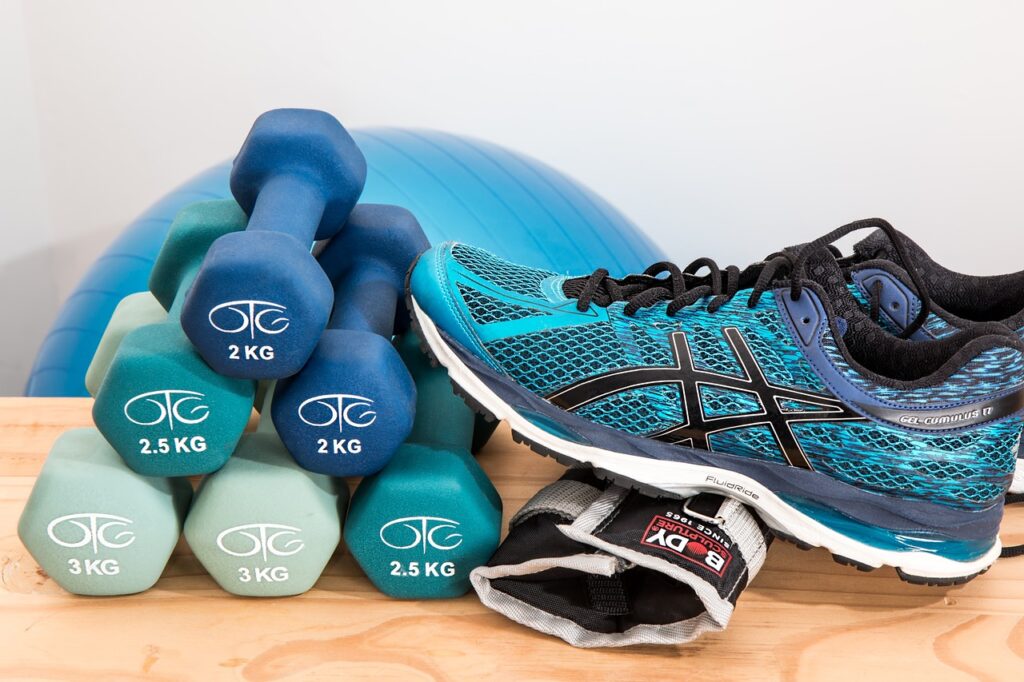If you’re looking to combat muscle atrophy, this article is just the right place for you. In this piece, we’ll explore the question of what exercise is good for muscle atrophy. As we delve into the topic, we’ll provide you with valuable insights and tips on how to fight Sarcopenia, which refers to the degradation of muscle in older adults. Be prepared to discover effective exercises and learn about the best muscle building products to help you regain strength and vitality. It’s time to take control of your health and boost your muscle power!

This image is property of pixabay.com.
Resistance Training
Benefits of Resistance Training
Resistance training, also known as strength training or weight lifting, offers numerous benefits for your overall health and well-being. By engaging in resistance training, you can increase muscle strength and mass, improve bone density, enhance metabolism, and boost your overall functional capacity. Additionally, this form of exercise can help prevent muscle atrophy, which is the degradation of muscle tissue commonly seen in older adults.
Types of Resistance Training Exercises
There are various types of resistance training exercises that you can incorporate into your fitness routine. Some of the most common options include using free weights such as dumbbells and barbells, utilizing resistance bands or tubes, using weight machines at the gym, and performing bodyweight exercises such as push-ups and squats.
Frequency and Duration of Resistance Training
To effectively combat muscle atrophy and experience the benefits of resistance training, aim to engage in this type of exercise at least two to three times per week. Each session should last approximately 30 to 60 minutes, allowing enough time to target different muscle groups. Additionally, be sure to allow for adequate rest and recovery between training sessions to promote muscle growth and prevent injury.
Safety Tips for Resistance Training
When engaging in resistance training, it is essential to prioritize safety to prevent injuries and maximize results. Make sure to warm up properly before each session by performing dynamic stretches and light cardio exercises. Start with lighter weights and gradually increase the resistance as your strength improves. Always maintain proper form and technique throughout each exercise to avoid strain or injury. Lastly, listen to your body and adjust the intensity and duration of your workouts according to your fitness level and any existing health conditions.
Cardiovascular Exercises
Benefits of Cardiovascular Exercises
Cardiovascular exercises, also known as aerobic exercises, provide numerous benefits for your cardiovascular system and overall health. These exercises increase your heart rate, improve lung function, strengthen your heart muscle, and enhance blood circulation throughout your body. Engaging in regular cardio exercises can also aid in weight management, reduce the risk of chronic diseases, and boost your mood and mental well-being.
Types of Cardiovascular Exercises
There are various types of cardiovascular exercises that you can choose from, depending on your preferences and fitness level. Some popular options include walking, jogging or running, cycling, swimming, dancing, aerobic classes, and using cardio machines such as treadmills or elliptical trainers. Experiment with different activities to find what you enjoy the most and can sustain in the long term.
Frequency and Duration of Cardiovascular Exercises
To reap the benefits of cardiovascular exercises and combat muscle atrophy, aim for at least 150 minutes of moderate-intensity aerobic activity per week. Alternatively, you can engage in 75 minutes of vigorous-intensity aerobic activity. If you’re a beginner, start with shorter sessions and gradually increase the duration and intensity over time. It is advisable to spread your cardio workouts throughout the week for optimal results.
Safety Tips for Cardiovascular Exercises
When engaging in cardiovascular exercises, it is crucial to prioritize safety to prevent injuries and promote overall well-being. Start each session with a warm-up that includes gentle movements and stretches to prepare your muscles and joints. Stay hydrated by drinking water before, during, and after your workout. Wear appropriate footwear and clothing to ensure comfort and support. If you have any underlying health conditions or concerns, consult with a healthcare professional before starting or intensifying your cardio routine.
Stretching and Flexibility Exercises
Benefits of Stretching and Flexibility Exercises
Stretching and flexibility exercises play a vital role in maintaining muscle health, preventing muscle atrophy, and improving overall flexibility and range of motion. By regularly incorporating stretching exercises into your fitness routine, you can enhance muscle elasticity, reduce muscle stiffness, and decrease your risk of injuries during physical activities. Additionally, stretching exercises can promote relaxation, relieve muscle tension, and improve posture.
Types of Stretching and Flexibility Exercises
There are different types of stretching exercises that target different muscle groups and promote varying levels of flexibility. Some common options include static stretches, which involve holding a stretch for a specific duration; dynamic stretches, which involve controlled movements that take your joints and muscles through a full range of motion; and proprioceptive neuromuscular facilitation (PNF) stretches, which involve a combination of stretching and contracting muscles.
Frequency and Duration of Stretching and Flexibility Exercises
To maintain muscle health and combat muscle atrophy, it is beneficial to incorporate stretching exercises into your fitness routine on a regular basis. Aim to stretch all major muscle groups at least two to three times per week. Each stretching session should last 10 to 30 minutes, focusing on both static and dynamic stretches. Remember to warm up your body before stretching to increase blood flow and prepare your muscles for elongation.
Safety Tips for Stretching and Flexibility Exercises
When engaging in stretching and flexibility exercises, it is important to follow certain safety guidelines to prevent injuries. Always start with a gentle warm-up, such as light cardio exercises or dynamic stretches, to increase body temperature and blood flow. Perform stretches after your workout or when your muscles are adequately warmed up. Avoid bouncing or jerking movements during stretches and maintain a relaxed breathing pattern. Never force a stretch beyond your comfort zone, and always listen to your body’s cues to prevent strain or injury.
Functional Training
Benefits of Functional Training
Functional training focuses on exercises that simulate real-life movements and enhance your ability to perform daily activities with ease. This type of training targets multiple muscle groups simultaneously, improves overall body strength and stability, and enhances your coordination and balance. By incorporating functional training into your fitness routine, you can better prevent muscle atrophy and improve your overall functional capacity.
Types of Functional Training Exercises
There is a wide range of functional training exercises that you can incorporate into your workouts. Some popular options include squats, lunges, planks, push-ups, burpees, medicine ball exercises, and kettlebell exercises. These exercises often involve compound movements that engage various muscle groups and promote functional strength and mobility.
Frequency and Duration of Functional Training
To reap the benefits of functional training and combat muscle atrophy, aim to include functional exercises in your fitness routine two to three times per week. Each session should last approximately 30 to 60 minutes, allowing ample time to perform a variety of functional exercises. It is important to listen to your body and adjust the intensity and duration of your workouts according to your fitness level and any existing health conditions.
Safety Tips for Functional Training
When engaging in functional training, it is crucial to prioritize safety to prevent injuries and optimize your results. Make sure to warm up before each session by performing dynamic stretches and light cardio exercises. Start with exercises that match your current fitness level and gradually progress to more challenging movements. Be mindful of maintaining proper form and technique throughout each exercise to avoid strain or injury. If you are new to functional training, consider working with a qualified fitness professional to ensure proper guidance and minimize the risk of injury.

This image is property of pixabay.com.
Balance and Coordination Exercises
Benefits of Balance and Coordination Exercises
Balance and coordination exercises are crucial for maintaining physical stability, preventing falls, and improving overall posture and body control. By incorporating these exercises into your fitness routine, you can enhance muscle strength, improve proprioception (awareness of body positioning), and enhance your overall balance and coordination. This can be particularly beneficial in older adults to prevent muscle atrophy and reduce the risk of falls.
Types of Balance and Coordination Exercises
There are various types of exercises that can help improve balance and coordination. Some common options include standing on one leg, heel-to-toe walk or balance, yoga poses, tai chi, and using balance boards or balance balls. These exercises often require focus and concentration, challenging your body to stabilize and coordinate movements effectively.
Frequency and Duration of Balance and Coordination Exercises
To improve balance and coordination and prevent muscle atrophy, aim to incorporate balance exercises into your fitness routine at least two to three times per week. Each session should last approximately 20 to 30 minutes, allowing enough time to perform a variety of exercises that challenge your stability. As you progress, you can increase the duration and intensity of your balance and coordination workouts.
Safety Tips for Balance and Coordination Exercises
Safety is crucial when engaging in balance and coordination exercises to prevent falls or injuries. Make sure to have a sturdy support nearby, such as a chair or wall, to assist if needed. Start with simple exercises and gradually progress to more challenging ones as your balance improves. Be cautious of your surroundings and choose a safe and clear area to perform these exercises. If you have any pre-existing health conditions or concerns, consult with a healthcare professional before starting or modifying your balance and coordination routine.
Low-Impact Exercises
Benefits of Low-Impact Exercises
Low-impact exercises offer a gentle yet effective way to engage in physical activity while minimizing stress on your joints and muscles. These exercises are particularly beneficial for individuals with joint pain, arthritis, or musculoskeletal conditions. By incorporating low-impact exercises into your routine, you can improve cardiovascular fitness, maintain muscle health, and prevent muscle atrophy without placing excessive strain on your body.
Types of Low-Impact Exercises
There are numerous low-impact exercises that you can choose from, depending on your interests and fitness level. Walking, swimming, cycling, using the elliptical machine, water aerobics, and rowing are all excellent examples of low-impact exercises. These activities provide cardiovascular benefits and can be easily modified to suit your needs and preferences.
Frequency and Duration of Low-Impact Exercises
To reap the benefits of low-impact exercises and prevent muscle atrophy, aim for at least 150 minutes of moderate-intensity aerobic activity or 75 minutes of vigorous-intensity aerobic activity per week. Spread your workouts throughout the week and strive to engage in low-impact exercises for at least 30 minutes per session. If you are new to exercise or have any existing health conditions, consult with a healthcare professional for guidance and recommendations.
Safety Tips for Low-Impact Exercises
When engaging in low-impact exercises, it is important to prioritize safety to prevent injuries and optimize your workouts. Make sure to warm up properly before each session by performing light cardio exercises and gentle stretches. Wear appropriate footwear that provides cushioning and support for your joints. Listen to your body and adjust the duration and intensity of your workouts based on your comfort level and any existing health conditions. If you experience any pain or discomfort during exercise, stop and consult with a healthcare professional.

This image is property of pixabay.com.
Joint-Strengthening Exercises
Benefits of Joint-Strengthening Exercises
Joint-strengthening exercises are essential for maintaining joint health, preventing injuries, and improving overall joint function and stability. By engaging in these exercises, you can strengthen the muscles and connective tissues surrounding your joints, reduce joint pain, and enhance your overall range of motion. Joint-strengthening exercises can be particularly beneficial for individuals with osteoarthritis or other joint-related conditions to prevent muscle atrophy and maintain joint integrity.
Types of Joint-Strengthening Exercises
There are various types of joint-strengthening exercises that you can incorporate into your fitness routine. Some examples include leg presses, squats, lunges, resistance band exercises, stability ball exercises, and yoga or Pilates exercises that focus on joint mobility and stability. These exercises target specific joint areas and muscle groups to improve joint strength and function.
Frequency and Duration of Joint-Strengthening Exercises
To effectively strengthen your joints and prevent muscle atrophy, aim to include joint-strengthening exercises in your fitness routine two to three times per week. Each session should last approximately 30 to 60 minutes, allowing enough time to target different joint areas and perform a variety of exercises. Gradually increase the resistance or difficulty level of your exercises as your strength improves over time.
Safety Tips for Joint-Strengthening Exercises
When engaging in joint-strengthening exercises, it is crucial to prioritize safety to prevent injuries and optimize your results. Make sure to warm up properly before each session by performing light cardio exercises and joint-specific stretches. Start with lighter weights or resistance and gradually progress as your joint strength improves. Maintain proper form and technique throughout each exercise to avoid unnecessary stress or strain on your joints. If you have any existing joint conditions or concerns, consult with a healthcare professional for personalized guidance and exercises modifications.
Aquatic Exercises
Benefits of Aquatic Exercises
Aquatic exercises, also known as water exercises or water aerobics, offer unique benefits due to the buoyancy and resistance provided by water. These exercises are gentle on the joints, making them particularly suitable for individuals with arthritis, joint pain, or injuries. Aquatic exercises improve cardiovascular fitness, enhance muscle strength and tone, promote joint flexibility, and can be an excellent choice for preventing muscle atrophy in a low-impact environment.
Types of Aquatic Exercises
There are numerous types of aquatic exercises that you can enjoy, depending on your preferences and fitness level. Some popular options include water walking or jogging, aqua aerobics classes, water Zumba or dance workouts, swimming laps, and using water weights or resistance bands. These activities provide a full-body workout and can be adjusted to match your abilities and goals.
Frequency and Duration of Aquatic Exercises
To experience the benefits of aquatic exercises and prevent muscle atrophy, aim to engage in water workouts at least two to three times per week. Each session should last approximately 30 to 60 minutes, allowing ample time to perform a variety of exercises that target different muscle groups. As with any exercise routine, start slowly and gradually increase the duration and intensity of your aquatic workouts according to your comfort level and fitness goals.
Safety Tips for Aquatic Exercises
When engaging in aquatic exercises, it is important to prioritize safety to prevent injuries and enjoy a safe and effective workout. Start each session by properly warming up and stretching before entering the water. Follow the instructions provided by qualified instructors during aqua aerobics classes to ensure proper form and technique. Use pool noodles or flotation devices as needed to support your body and maintain proper posture in the water. Stay hydrated throughout your workouts and be mindful of any pool rules or guidelines for your safety. If you have any underlying health conditions, consult with a healthcare professional before starting or modifying your aquatic exercise routine.
Additional Considerations for Aquatic Exercises
When engaging in aquatic exercises, consider the following additional considerations:
Pool Depth: Ensure the water is at an appropriate depth for safe movement and exercise. If necessary, choose a pool with varying depths or areas specifically designed for water workouts.
Pool Temperature: Opt for a pool with a temperature that is comfortable for you. Warmer water can help promote relaxation, while cooler water may provide a refreshing experience.
Water Resistance: Take advantage of the natural resistance provided by water during your exercises. This resistance can enhance muscle strength and promote overall fitness gains.
Aqua Equipment: Consider using water-specific equipment such as flotation belts, water dumbbells, or resistance gloves to add variety and intensity to your aquatic workouts.
Safety Personnel: If engaging in aquatic exercises in a public pool or unfamiliar environment, ensure that there are qualified lifeguards or safety personnel available in case of emergencies.

Mind-Body Exercises
Benefits of Mind-Body Exercises
Mind-body exercises, also known as holistic exercises, focus on the connection between the mind, body, and spirit. These exercises are designed to promote relaxation, reduce stress levels, and enhance overall well-being. By engaging in mind-body exercises, you can improve mental clarity, reduce anxiety and depression, increase body awareness, and maintain muscle health, thus aiding in the prevention of muscle atrophy.
Types of Mind-Body Exercises
There are various types of mind-body exercises that you can incorporate into your fitness routine. Some popular options include yoga, tai chi, Pilates, and meditation. These exercises emphasize controlled movements, deep breathing techniques, mindfulness, and relaxation to promote harmony between the mind and body.
Frequency and Duration of Mind-Body Exercises
To harness the benefits of mind-body exercises and prevent muscle atrophy, aim to engage in these activities at least two to three times per week. Each session can last anywhere from 20 minutes to an hour, depending on your preferences and the specific exercise. Regular consistency and commitment are key to experiencing the full advantages of mind-body exercises.
Safety Tips for Mind-Body Exercises
Safety is vital when engaging in mind-body exercises to ensure a positive and rewarding experience. Listen to your body and respect its boundaries, avoiding any movements or stretches that cause pain or discomfort. Begin with beginner-level classes or instructional videos if you are new to these exercises to learn proper form and technique. Always consult with a healthcare professional if you have any existing health concerns or conditions to ensure that the exercises are suitable for your needs.
Combination Exercises
Benefits of Combination Exercises
Combination exercises, also known as compound exercises, involve movements that target multiple muscle groups simultaneously. These exercises provide a comprehensive and efficient way to engage in strength training and cardiovascular exercise simultaneously. By incorporating combination exercises into your fitness routine, you can save time, improve overall fitness, and prevent muscle atrophy.
Types of Combination Exercises
There are numerous combination exercises that you can include in your workouts, allowing you to engage multiple muscle groups and challenge your body in various ways. Some examples include squat to shoulder press, lunge with bicep curl, deadlift with upright row, and plank with row. These exercises often involve using free weights, resistance bands, or weight machines to add resistance and intensity.
Frequency and Duration of Combination Exercises
To optimize the benefits of combination exercises and combat muscle atrophy, aim to include them in your fitness routine two to three times per week. Each session should last approximately 30 to 60 minutes, allowing ample time to perform a variety of exercises targeting different muscle groups. As with any training regimen, listen to your body, and adjust the intensity and duration of your workouts based on your fitness level and any existing health conditions.
Safety Tips for Combination Exercises
When engaging in combination exercises, it is essential to prioritize safety to prevent injuries and maximize results. Ensure that you are using proper form and technique for each exercise to avoid strain or injury. Start with lighter weights or resistance and gradually increase the intensity as your strength improves. Engage your core muscles to maintain stability and control throughout each movement. Always warm up properly before each session, and if you are new to combination exercises, consider working with a qualified fitness professional for guidance and support.
By incorporating a variety of exercises from different categories into your fitness routine, you can effectively combat muscle atrophy, improve overall fitness levels, and enhance your overall health and well-being. Remember to listen to your body, start with appropriate exercises for your fitness level, and gradually progress as you build strength and stamina. With consistency, dedication, and these safety tips in mind, you can enjoy the benefits of exercise and maintain muscle health for years to come.



